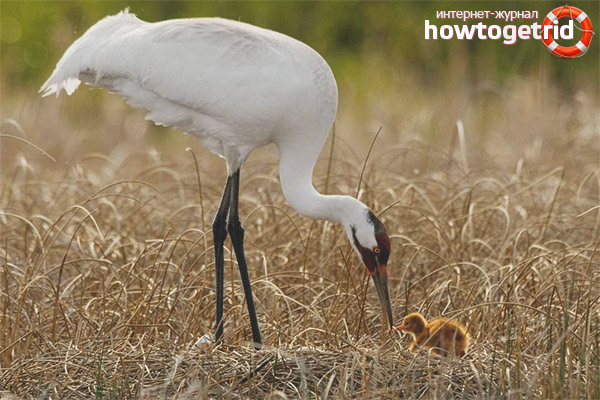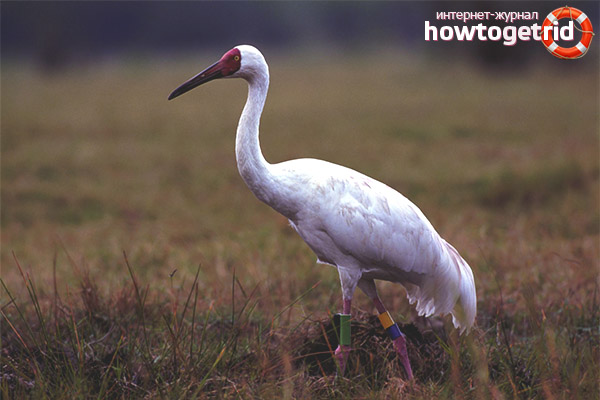The content of the article
Today, there are a lot of different species of not only animals, but also birds that are threatened with extinction. In conservation areas and zoos, conservationists take many different measures to ensure that endangered species retain their population. Sterkh is one of such birds. People call him the white crane.
Description of Siberian Crane
The bird is majestic and beautiful, is a long-liver, as it can live up to 70 years. You can’t call the Siberian Crane a small bird, since its body size can reach up to 150 cm, and the length of the wings during the wingspan is up to 2.5 meters. The adult crane weighs 8-8.5 kg.
Such a bird has a beautiful snow-white plumage, but this does not apply to the head and wings. The eye and beak areas of the crane are fiery red. If the bird meets for the first time, then it may seem that she has an aggressive look. Long beak, eye color red or light yellow. Paws straight, long, pale pink.
If the crane is young, then the color of its plumage will be light brown. Males differ from females in size and growth, they are larger and taller.
Crane Habitat
Cranes are protected by law and regular measures are taken to combat its disappearance. In spring, the birds return to their homeland. They nest in places that a person cannot reach. Swamps, impassable forests and tundra are chosen for this. The bird dwells in its place until frost and cold begin.
The white crane population is divided into two groups - it is western and eastern. Their difference is only in the nesting place. Around the world today there are about 3,000 Siberian Cranes. It is difficult enough to survive in the natural environment. The population does not cope with weather and natural conditions.
Nutrition
The bird from the crane family is not picky about food, and we can say that it is omnivorous. In her diet there is food of plant origin and animal. When there is no cold and still warm, the white crane eats berries, seeds, catches frogs and insects, can fish, eats small birds and their eggs.
When colds come and the birds migrate to a warmer place for wintering, the basis of their diet is underwater rhizomes, sedge and small rodents living in water.
Crane breeding

The white crane is a monogamous bird. The male chooses a female during the mating season and stays with her until the end. In late spring, they begin to nest. It is very interesting to watch the Siberian Crane during mating, the individual performs movements similar to a dance and sings songs. Having selected a female, the crane raises its head to the sky and begins to make lingering sounds, after which it flaps its wings and bounces, can toss branches. That is to say, this is courtship by the male, at this time the female stands and watches what is happening, pressing her wings to her body.
Cranes nest in places that are clearly visible. Before this, birds stock up on food and water. The nest is built together, most often the place is in a shallow pond. Thus, they protect their chicks from hunters and other animals.
At one time, the female Siberian Crane can lay one or two eggs. They are gray, have dark dots on the shell. Hatching lasts an average of 29 days, and then chicks appear.The chicks have blue eyes for the first six months, but their color changes over time. From the very first day of life, chicks must be able to defend themselves. Usually, only one chick remains from the brood, and one that is weaker dies. After 70 days, the bird acquires a light brownish tint, and only after three years the young eave turns into a white crane.
In order to reduce the disappearance of these representatives, people try as much as possible to domesticate the birds in order to preserve them. In zoos, Siberian Cranes are kept in pairs - it is believed that together they will quickly get used to and will be able to better adapt.
The conditions for keeping birds should be as close to natural as possible. Often, a pair of cranes settles on the shores of artificial ponds where dense shrubs and a lot of vegetation are planted.
The white crane is such a bird that will not immediately be friends with a person and once again it will not approach him. They will not feed from a human hand.
What is being done to protect Siberian Cranes?
In addition, according to the project Flight of Hope, which is controlled by the president himself, small Siberian Cranes are also raised in captivity. Specialists are preparing chicks for an independent adult life. To make it easier for the chick to perceive the environment, the workers of this nursery put on a suit in the form of a stork, he has specially made one sleeve like the head of a crane. So you need to be able to stroke the chick (the parents of the cranes stroke their chicks with their heads).
A man fully educates the chick, starting from the search for food and ending with the flight, so that it is easier for him to survive in the natural environment. Using a special flying device, young Siberian Cranes are lifted into the air, people are controlling it below. To the place of accumulation of the first white cranes, people escort young chicks, and then they independently settle in with their relatives.
Interesting facts from the life of Siberian Cranes
- In the countries of India, white cranes are called lily birds. Even Gandhi issued an order, which said that to create a park for the wintering of Siberian Cranes with a special regime and special living conditions for these birds.
- Of all species of cranes, the Siberian Crane can cover the largest distance - it is approximately 5.5 thousand km. Twice a year, Siberian Cranes fly over 9 countries.
- In Dagestan, they came up with a legend about white cranes: during migration they cross this country and people say that they are the souls of warriors. The poet Rasul Gamzatov has poems based on this legend.
- When the Siberian Cranes begin their mating season, they sleep two hours a day.
- The white crane for Khanty and Mansi is a sacred bird that is present in every rite and tribal totem.
- The Khanty people will not bother the bird - there is a definite ban on visiting Siberian Crane nesting sites in spring and summer.











Submit